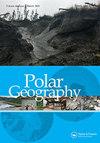Learning and insights from a participatory photography project with Cree and Inuit about the land (Nunavik, Canada)
IF 1.6
Q3 GEOGRAPHY, PHYSICAL
引用次数: 6
Abstract
ABSTRACT In the Arctic, participatory researches that build bridges between Western academics and indigenous communities are increasing and are necessary to promote what Raheja [2007. Reading nanook’s smile: Visual sovereignty, indigenous revisions of ethnography, and atanarjuat (The Fast Runner). American Quarterly, 59(4), 1159–1185.] called ‘visual sovereignty’ and narrative sovereignty of the people of the North. This research project was carried out with Cree and Inuit communities in Nunavik, Canada on their perception of the land particularly in the context of the creation of the Tursujuq National Park. This paper presents and discusses the benefits and challenges regarding the participatory research design of the project and the methods employed with a special focus on participatory photography. It highlights the importance of using participatory methods in the cultural dynamics and practices of the communities. The paper illustrates and analyses some learnings and insights that emerged from developing participatory research in this intercultural context between indigenous and non-indigenous partners by focusing on rapport-building and community engagement.从与克里人和因纽特人一起参与的土地摄影项目中学习和洞察(加拿大努那维克)
在北极,在西方学者和土著社区之间建立桥梁的参与性研究正在增加,并且有必要促进Raheja[2007]所做的工作。阅读纳努克的微笑:视觉主权,民族志的本土修订,以及《快跑者》。美国季刊,59(4),1159-1185。称之为“视觉主权”和北方人民的叙事主权。这个研究项目是与加拿大努那维克的克里人和因纽特人社区一起进行的,研究他们对土地的看法,特别是在建立图尔苏朱克国家公园的背景下。本文介绍并讨论了项目参与性研究设计的好处和挑战,并特别关注参与性摄影所采用的方法。它强调了在社区的文化动态和实践中使用参与式方法的重要性。本文阐述和分析了在土著和非土著合作伙伴之间的跨文化背景下开展参与性研究所获得的一些经验和见解,重点是建立关系和社区参与。
本文章由计算机程序翻译,如有差异,请以英文原文为准。
求助全文
约1分钟内获得全文
求助全文
来源期刊

Polar Geography
GEOGRAPHY, PHYSICAL-
CiteScore
5.30
自引率
0.00%
发文量
13
期刊介绍:
Polar Geographyis a quarterly publication that offers a venue for scholarly research on the physical and human aspects of the Polar Regions. The journal seeks to address the component interplay of the natural systems, the complex historical, political, economic, cultural, diplomatic, and security issues, and the interchange amongst them. As such, the journal welcomes comparative approaches, critical scholarship, and alternative and disparate perspectives from around the globe. The journal offers scientists a venue for publishing longer papers such as might result from distillation of a thesis, or review papers that place in global context results from coordinated national and international efforts currently underway in both Polar Regions.
 求助内容:
求助内容: 应助结果提醒方式:
应助结果提醒方式:


